Well, it’s High Summer once again, and you know what that means for we horticulturalists: gardening time! As you might expect, high-quality fencing can really come in handy—for partitioning crops, keeping unwanted critters out, or keeping wanted critters in.
Given the general state of The Mess these days, I feel it’s only appropriate to take a second look at those skill-sets that fell by the wayside in the course of our culture’s drunk-on-fossil-fuels bender of industrialization. Of course, the ‘old’ ways of doing things were—by their comparatively low-impact nature—far more sustainable than the way most do things now, and so are definitely worth checking out.
And so, we’re going to learn how to make WATTLE!
But for starters, what is wattle?
Believe it or not, ‘wattle’ is one of the oldest building materials known to man. The technique dates solidly back to Neolithic Old Europe, and conceivably could even have been used in the Upper Paleo/Mesolithic (as a very field-expedient fire-reflecting or windbreaking addition to a shelter?).
Although these days, most people’s only exposure to wattle is in a basic history class (where it is paired with ‘-and-daub’, usually in an off-hand reference to medieval peasant building techniques – in the same way that cob or adobe construction might get glossed over as ‘mud bricks’), this valuable skill is luckily still kept alive by village elders in those quaint corners of Britain where petroleum culture never fully caught on or was resisted.
Traditionally in Britain, wattle was built of coppiced hazel and willow, but since I live in the Ohio valley, and strongly believe in using materials native to one’s area, I am very fond of using river-cane (genus Arundinaria). A grasslike relative of bamboo, this wonderfully sustainable resource once choked the banks and bottoms of old Mississippia in the form of nigh-impenetrable ‘canebreaks’, providing a number of valuable materials to the locals. From this one plant can be made such a diverse list of items useful to Mississippian Hobbits like myself: atlatl darts and arrow shafts, musical instruments, drinking straws, needle-cases (and other tube-y containers), bedding, roofing thatch, and our focus today, wattle!
What you’ll need:
-raw natural materials (hazel, willow, cane, basswood, &c): a big pile of long pieces (~eight foot or so) for the horizontal weaving, and a handful of thicker pieces for uprights (~four foot tall).
-a hammer or post-driver
-a suitable outdoor workspace
-a free hour or two
-an open mind
(Note: While ‘wattle’ is the general name for woven wooden material, our finished unit is known as a ‘hurdle’.)
While most traditional hurdlers will start from a mould-board (a long, slightly-curved piece of wood to hold the stakes), for my quick-and-dirty uses I found that pounding the sharpened uprights about six inches to a foot into the ground works just fine. This leaves about three or four feet above ground for the height of the hurdle. Keep about twelve to eighteen inches between the uprights, and I’ve found that mimicking the slight arc shape of a mould-board works well.
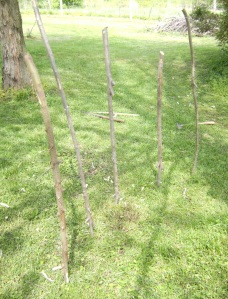
*In my examples, the uprights are either apple wood, or leftover bamboo. If you use something like apple, make sure to orient the stakes opposite to how they grew (the thinner end should be in the ground), as the nubs of pruned-off branches really helps to ‘lock’ each course of material in place.
Note: the benefit of using traditional woods like hazel and willow is that they are very bendable. This ability comes in handy every few rows, when you want to bend the excess length back upon itself to keep the outermost uprights in place. Unfortunately, cane doesn’t lend itself to this tricky maneuver very well, so if you’re doing a cane hurdle you may have to use a row of one of these more flexible materials every now and then.
Once your uprights are in place, there’s really not much to weaving wattle, and pictures are worth a thousand words:

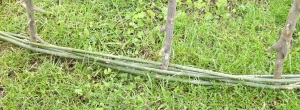
Basically, just keep alternating weaving your long pieces behind and in front of your uprights, and twisting the ends back upon themselves every few rows. In an hour or two or so, you should wind up with something like this!:
Or this!
Or this!
As you can see, attractive—or at the least, utilitarian!—wattle hurdles like these can be assembled quite easily with only a little time and effort, and they make great ‘primitive’/’traditional’/’rustic’ accents to a garden plot or small livestock paddock.
However, as easy as they are to make, the one thing required for building them which most folks might have trouble finding would be the raw materials themselves! For those of you in the States who don’t have access to a private woodland, you might start by asking around at your local greenhouse or nursery.
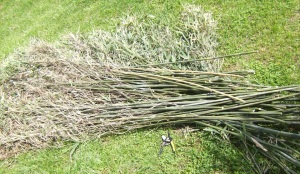
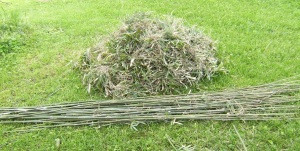
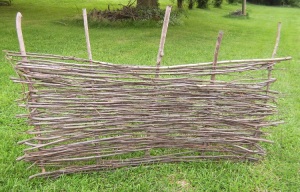
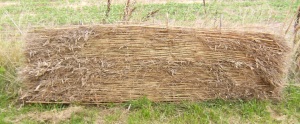
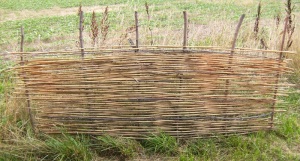
Posted by melina kahn on 22 June, 2014 at 10:37
My family always say that I am killing my time here at net, however I know I am getting knowledge all the time by reading such pleasant articles.
Posted by orctu on 15 March, 2015 at 03:59
Very cool building wattles with cane. I’m here in Georgia hoping to do something similar. One question though, just how flexible are they? Could you make a curved 90 degree bend without too much trouble?
Thanks for sharing!
Posted by A. on 18 March, 2015 at 20:42
Hmmmm. It might be possible to get a sharp bend out of a split green piece (as in basketry)…in bending cured pieces with heat I’ve never produced that dramatic of a bend.
If you want a 90-degree bend in whole (round) cane, I wonder if you could train it ‘bonsai’-style while it’s growing green?